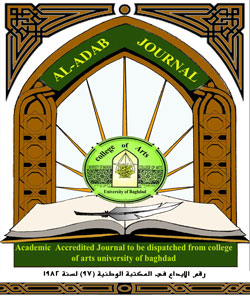Semantic interconnection in the prophetic speech
DOI:
https://doi.org/10.31973/aj.v0i114.1328Keywords:
/Abstract
How semantic correlation enables the listener to recognize the flow of meaning resulting from the organization of the text of the speech and cohesion, And has become a rhetorical text communication unit understandable homogeneous organization and sequence of construction and the link between sentences speech row.
Shows the creativity of Prophet Mohammad in the selection and installation of the vocabulary within the context of the explosion of energies bearing in mind the meanings of the vibrant place to conditions, This communication between the holder and the message recipients of the speech is the foundation upon which to build in the face of social language, It is the relationships and events, which dominates the atmosphere hour performance of the article and determine the significance and the subject comes from a concerted attitudes and texts.
Valkhtabh happened and my goal for the content and position of the contact, communication and the actual practice of social text operative achieves the intent and acceptance by informing and influencing perceived in a certain way information between the event and context of verbal, To understand the event rhetorical means knowing the sender, the receiver, and the relationship between them in which the temporal and spatial, Valkhtaib has a clear impact on the subject of rhetoric and content, construction and context, he is controlling element in the subject and content and the receiver upon the listener to follow Khatib in what he hears and understands what is meant by the sermon of indication and suggestion
Downloads
References
- الاتقان في علوم القران للسيوطي جلال الدين- تحقيق محمد أبو الفضل- المكتبة العصرية- صيدا- لبنان- 1997م.
- الإيضاح في علوم البلاغة للخطيب القزويني- دار إحياء العلوم- ط2 بيروت- 1993م.
- البحر المحيط لأبي حيان الأندلسي- تحقيق د. عبد الرزاق المهدي- دار إحياء التراث العربي- ط1- بيروت- 2002م.
- بدائع الفوائد لابن قيم الجوزية- مكتبة الصفا- ط1- 2005م.
- البرهان في علوم القران للزركشي بدر الدين – تحقيق محمد أبو الفضل إبراهيم دار المعرفة- ط2- بيروت- د. ت.
- البيان والتبين لأبي عثمان الجاحظ- تحقيق فوزي عطوي- دار صعب ط1- بيروت- 1968م.
- جمهرة خطب العرب في عصور العربية الزاهرة لاحمد زكي صفوت المكتبة العلمية- بيروت- د. ت.
- الجوانب الاعلامية في خطب الرسول لسعيد بن علي ثاب- وزارة الشؤون الاسلامية والاوقاف- ط1 السعودية- 1417هـ.
- دلائل الاعجاز لعبد القاهر الجرجاني- تعليق وشرح محمد عبد المنعم خفاجي مطبعة الفجالة الجديدة- ط1- مصر- 1969م.
- دلالة الالفاظ – د. إبراهيم أنيس- المطبعة الفنية الحديثة- ط3- 1976م.
- دور الكلمة في اللغة لستيفن أولمان- ترجمة د. كمال محمد بشر مكتبة الشباب- ط3- 1972م.
- الصناعتين لأبي هلال العسكري- تحقيق علي محمد البجاوي ومحمد أبو الفضل إبراهيم- المكتبة العصرية- بيروت- 1419هـ.
- علم الدلالة لاحمد مختار عمر- عالم الكتب- ط5- 1998م.
- علم الدلالة العربي د. فايز الداية- دار الفكر- ط1- 1985م.
- علم الدلالة- كلود جيرمان وريمون لوبلان- ترجمة د. نور الهدى لوشن دار الفاضل- دمشق- 1994م.
- علم الدلالة منضور عبد الجليل- منشورات اتحاد الكتاب العرب- دمشق- 2001م.
- علم لغة النص- النظرية والتطبيق د. عزة شبل محمد – مكتبة الآداب- ط1- القاهرة- 2007م.
- علم لغة النص والأسلوب- نادية رمضان النجار- مؤسسة حورس الدولية- جامعة حلوان- مصر- 2013م.
- لسانيات النص- مدخل على انسجام الخطاب- محمد خطابي- المركز الثقافي العربي- ط1- 1991م.
- اللغة العربية معناها ومبناها- د. تمام حسان- عالم الكتب- ط3- 1998م.
- اللغة والمعنى والسياق- جون لاينز- ترجمة د. عباس صادق الوهاب- دار الشؤون الثقافية- بغداد- ط1- 1987م.
- مناهج البحث في اللغة – د. تمام حسان- مطبعة النجاح- الدار البيضاء- المغرب 1979م.
- نحو النص – إطار نظري ودراسات تطبيقية- عثمان أبو زيند- عالم الكتاب الحديث- ط1- 2010م.
Downloads
Published
Issue
Section
License
Copyright and Licensing:
For all articles published in Al-Adab journal, copyright is retained by the authors. Articles are licensed under an open access Creative Commons CC BY 4.0 license, meaning that anyone may download and read the paper for free. In addition, the article may be reused and quoted provided that the original published version is cited. These conditions allow for maximum use and exposure of the work.
Reproducing Published Material from other Publishers: It is absolutely essential that authors obtain permission to reproduce any published material (figures, schemes, tables or any extract of a text) which does not fall into the public domain, or for which they do not hold the copyright. Permission should be requested by the authors from the copyrightholder (usually the Publisher, please refer to the imprint of the individual publications to identify the copyrightholder).
Permission is required for: Your own works published by other Publishers and for which you did not retain copyright.
Substantial extracts from anyones' works or a series of works.
Use of Tables, Graphs, Charts, Schemes and Artworks if they are unaltered or slightly modified.
Photographs for which you do not hold copyright.
Permission is not required for: Reconstruction of your own table with data already published elsewhere. Please notice that in this case you must cite the source of the data in the form of either "Data from..." or "Adapted from...".
Reasonably short quotes are considered fair use and therefore do not require permission.
Graphs, Charts, Schemes and Artworks that are completely redrawn by the authors and significantly changed beyond recognition do not require permission.
Obtaining Permission
In order to avoid unnecessary delays in the publication process, you should start obtaining permissions as early as possible. If in any doubt about the copyright, apply for permission. Al-Adab Journal cannot publish material from other publications without permission.
The copyright holder may give you instructions on the form of acknowledgement to be followed; otherwise follow the style: "Reproduced with permission from [author], [book/journal title]; published by [publisher], [year].' at the end of the caption of the Table, Figure or Scheme.












